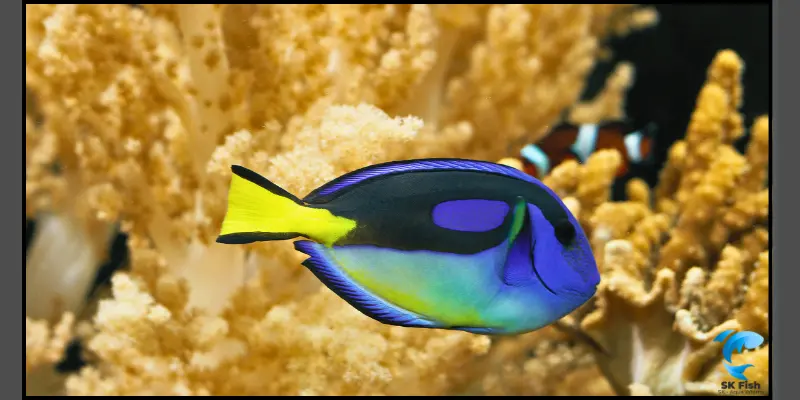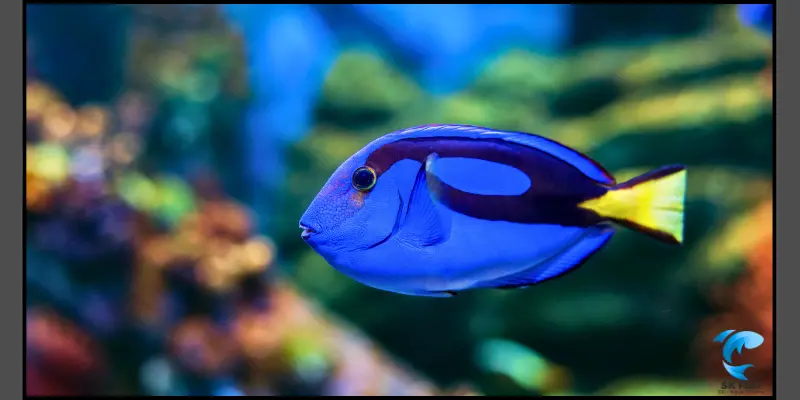Regal Tang | Essential Caring Tips – A Complete Guide
Published: 20 Jan 2024
Regal tang — a beautiful blue body is a popular fish for aquariums. Its body is crafted beautifully with three colors: royal blue, yellow tail, and black. The scientific name of regal tang is “Paracanthrus Hepatus”.
Are you a marine enthusiast looking for essential caring tips for regal tang? You’re at the right place. In this blog post, we explore all the essential tips and learn more about the regal tang.
Let’s get started!
What is Regal Tang?
A beautiful blue body with a yellow and black spine has always made the regal tang one of the most beloved tropical fish worldwide. It is listed as one of the most beautiful fish at the Blue Planet Aquarium. Regal tangs belong to the surgeonfish family, one of the 75 species of surgeonfish.
Are you curious about more interesting facts about tangs? Get ready to plunge into the blue tang world and explore their fascinating characteristics.

Common Names
The Regal Tang is known by various names in different countries. Some of these names include Blue Tang, Royal Blue Tang, Surgeonfish, Palette Surgeonfish, Flagtail Surgeonfish, Blue Surgeonfish, Hippo, Hepatus Tang, and Indo-Pacific Blue Tang. However, the most common name for the Regal Tang is ‘Blue Tang‘.
Weight and Size
Firstly, the tang’s weight and size are measured according to their age. It is a small marine fish – Such as the adult weight of regal is usually 500-900 grams. They typically reach up to the maximum size of 28-37cm. The body structure of the tang is almost circular and flat like a striped bass.
Lifespan and Reproduction
The lifespan of our blue tang depends on its environment, with the wild playing a crucial role in the life of the Blue Tang. In its natural habitat, the tang can live for 25-30 years. However, in captivity, the lifespan is generally shorter than that in the wild.
The reproduction of the regal tang involves a process. During this process, the male tang releases sperm into the open waters of the ocean, and the female tang releases over 42,000 eggs above the coral. These eggs hatch in just 24 hours, and the young tangs can reach maturity after 8 to 11 months.
Habitat and Distribution
Let’s delve into the discussion of their habitat, distribution, and the challenges they encounter throughout their lives.

Versatile Habitat
The habitat of the blue tang is primarily dictated by its environment. Often, they inhabit coral reefs and tropical waters of the ocean, commonly found at depths ranging from 5 to 135 feet. These fish thrive in the warm waters of the ocean, where the temperature typically ranges from 20°C to 30°C.
Distribution
The regal tang is indigenous to the Indo-Pacific Ocean and is distributed globally, spanning oceans such as the Indian Ocean, Red Sea, Indonesia, East Africa, the Caribbean Sea, and the western Atlantic Ocean from New York to Samoa, the Gulf of Mexico, Sri Lanka, and Japan.
They are typically found in pairs, indicating a group-oriented lifestyle. This fish is highly sought after in the marine aquarium trade, with increasing demand attributed to its unique body structures and diverse colors.
Threats
The regal tang is not considered endangered, primarily due to its habitat within coral reefs, providing natural protection. The tendency of regal tangs to form groups also offers them a beneficial advantage. However, they face significant threats from larger predators such as groupers, tuna, and sharks.
Aquarium Caring Tips
Remember, everything requires proper attention — and the same goes for the proper care of the Regal Tang. So, let’s delve into exploring more:

Tank Size
Tangs come in various sizes in the market, and for optimal well-being, the recommended tank size is typically 75-100 gallons. However, the ideal tank size for regal tangs is around 200 gallons. It’s crucial to ensure that the available space allows for adequate swimming room for the tang. Often, they are collected from the wild at a very small size, typically around 1 inch.
Tank Decor
Tank decoration is essential to create a suitable environment for tangs, resembling their natural ocean habitat. Incorporating live rocks not only enhances the aesthetic appeal but also provides hiding spots and a more natural setting for the fish.
Water Conditions
Regal tangs thrive in saltwater environments and cannot survive in freshwater. Ensuring optimal water conditions is crucial for the well-being of tangs. Adequate oxygen supply is essential, achieved through water movement, which promotes oxygenation.
Maintain stable water conditions by balancing the pH between 8.1 to 8.4 and salinity around 1.021 to 1.025. As inhabitants of warm waters, the recommended temperature range for their environment is 20°C to 30°C.
Filtration
Another crucial aspect of caring for the regal tang is filtration. Proper water filtration plays a vital role in ensuring their well-being. Utilizing tools such as protein skimmers is beneficial for removing impurities and maintaining high water quality.
Feeding Habits
Regal tangs are herbivores and require a diet rich in vegetables. Live rock in the tank provides algae, an essential component of the tang’s diet. Offering a variety of foods, including marine flakes, pellets, frozen or live food, nori, and lettuce, ensures a well-rounded diet for regal tangs. These types of food are often available at pet shops.

Interesting Facts About Regal Tang
- The blue tang is popular because of their vibrant colors, contributing to its popularity in the aquarium trade.
- The other thing that renowned tang is “Finding Dory”. It’s an animated film that makes Regal renowned. When “Finding Nemo” was released then the demand for Nemo skyrocketed.
- As herbivores, the natural diet of blue tang is algae and seaweed.
- The kingdom of the tang is Animalia.
- They are commonly found in groups.
- They were renowned due to their active and energetic swimming behavior.
- The lifespan of tang in captivity is 15 to 20 years but in the wild, they reach up to 30 years.
Conclusion
In this blog post, we’ve delved into all the essential aspects of regal tangs. From exploring their various names, sizes, weights, lifespans, and reproduction to understanding their habitat, distribution, threats, and unique care tips, we’ve covered it all. I hope this comprehensive information has enlightened you about these fascinating fish. Feel free to share your thoughts in the comment section below.
Frequently Asked Questions
What type of animal is a blue tang?
The blue tang is a gorgeous fish, distinguished by a sharp, retractable spine on each side of its tail. It is highly sought after in the aquarium trade. Additionally, being a herbivorous species, its natural diet consists of algae and seaweed.
Is a blue tang venomous?
Yes, the blue tang is venomous, and it is not consumed as food. These fish are primarily caught for aquariums. It’s important to note that consuming this fish may lead to ciguatera poisoning.
What size tank does a regal tang need?
The recommended tank size for a regal tang is typically 75 to 100 gallons, but it’s important to ensure that there is enough space for the tang to swim comfortably. Ideally, a tank size of 200 gallons is considered optimal for the well-being of the regal tang.
What color is a regal tang?
The Regal Tang is found in various colors, including blue, yellow, yellow belly, black, and purple tang. Renowned for their vibrant hues and sleek, flat bodies, they are truly a sight to behold.

SK Fish is your trusted source for practical fish care tips and delicious seafood recipes. Our team is dedicated to providing reliable, well-researched content for fishing enthusiasts and home cooks alike.

- Be Respectful
- Stay Relevant
- Stay Positive
- True Feedback
- Encourage Discussion
- Avoid Spamming
- No Fake News
- Don't Copy-Paste
- No Personal Attacks



- Be Respectful
- Stay Relevant
- Stay Positive
- True Feedback
- Encourage Discussion
- Avoid Spamming
- No Fake News
- Don't Copy-Paste
- No Personal Attacks





